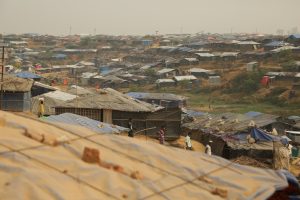Sebastian Strangio

In the 10 months since the Myanmar military’s seizure of power tipped the nation into a toxic, nationwide political emergency, another serious crisis – that facing the Rohingya refugees of Bangladesh – has largely been consigned to the margins of international attention.
More than 1 million mostly Muslim Rohingya civilians have been entrapped, limbo-like, in the rambling refugee camps that surround the town of Cox’s Bazar in southeastern Bangladesh, since fleeing in scorched-earth military offensives in Myanmar’s Rakhine State in 2016 and 2017. While a solution was remote even before the coup, the new crisis has further compounded their troubles, complicating any resolution to the refugee emergency, while also distracting international attention away from what might be done to resolve it.
A special rapporteur of the United Nations said on Sunday that despite the country’s current troubles, the world should not forget the massive humanitarian crisis next door in Bangladesh, nor the Myanmar armed forces’ ultimate responsibility for creating it.
Speaking during a visit to Bangladesh, during which he met Rohingya refugees, government officials, and representatives from international aid agencies, Tom Andrews, the U.N.’s Special Rapporteur on the human rights situation in Myanmar, said that he would continue to push for stronger and more coordinated international efforts.
“I will do everything in my capacity to push for a stronger, more coordinated international response to this crisis, including the imposition of pressure on the Myanmar military and for concrete measures to hold the military junta fully accountable for this crisis,” he told reporters in the capital Dhaka, as reported by the Associated Press.
He also said that the world should rethink the ways they would respond to the crisis in the future. “I believe that there must be a fundamental reassessment of how we, as an international community, have responded to this crisis. This means consideration of options to increase pressure on the military regime. It also means consideration of how we support its victims, including the Rohingya community,” he said.
The trouble is that a resolution to the Rohingya crisis was complex even prior to the coup. At that time, a solution to the refugee crisis hinged on paving the way toward voluntary repatriation of Rohingya refugees to the villages that they fled at the point of a bayonet in 2016 and 2017. The problem was that the conditions within Rakhine State were mostly inhospitable to the return of those who fled.
Rohingya returnees would face the likely hostility of the military and the Buddhist Rakhine nationalists, who made up the vigilante groups that accompanied the military’s “clearance operations” in 2017. The outbreak of civil war between the Myanmar government and the Arakan Army (AA) in 2018 then led to further displacements of civilian populations in Rakhine State and threw up an additional obstacle to voluntary repatriations. As Andrews recognized, “the conditions for the safe and sustainable, dignified return of Rohingya to their homeland currently do not exist. It’ll take considerable time and significant efforts to create such conditions in Myanmar.”
With little hope of voluntary returns, the Bangladeshi government has advanced its own partial solutions. One of these has been the relocation of Rohingya to Bhasan Char, a wind-swept island in the Bay of Bengal. More than 19,000 people have been relocated to the island, with Dhaka targeting as many as 100,000. But human rights advocates claim the island is inhospitable and have documented many instances in which civilians were coerced into moving to the island. Writing in The Diplomat this week, Zaw Win of the advocacy group Fortify Rights argued that the facilities on Bhasan Char were “closer to an island prison than an appropriate location for refugees.”
According to Andrews, the path to a solution lies through pressing the Myanmar military junta with punishing economic embargoes and sanctions, designed to strangle its manifold revenue sources. “It’s a large military and it’s very formidable,” he said of the Myanmar military, “but large militaries take significant resources to supply and sustain. I think that the international community can do a much better job of identifying sources of revenue that are flowing into the coffers of this military junta and perpetuating these atrocities.”
Of course, his use of the phrase “international community” suggests a stronger degree of unity than what exists in practice and elides the fact that the major powers and regrettably divided in their approach to the situation. In particular, Russia has seen the coup as an opportunity to boost its arms sales to Myanmar and undermine the moral authority of the West, while neighboring China, perhaps convinced the military will ultimately succeed in consolidating its coup, has prioritized the preservation of its strategic and economic stakes over exercising its leverage over the junta. (Beijing is also an important source of arms for the Tatmadaw.)
The solution laid out by Andrews is not only the best solution to the crisis in Myanmar; it is likely the only one. But any attempt to starve the Myanmar military into submission is likely to take some time. Like many of Myanmar’s challenges, any resolution to the Rohingya crisis will rely heavily on a resolution to the country’s wider political impasse.
No comments:
Post a Comment